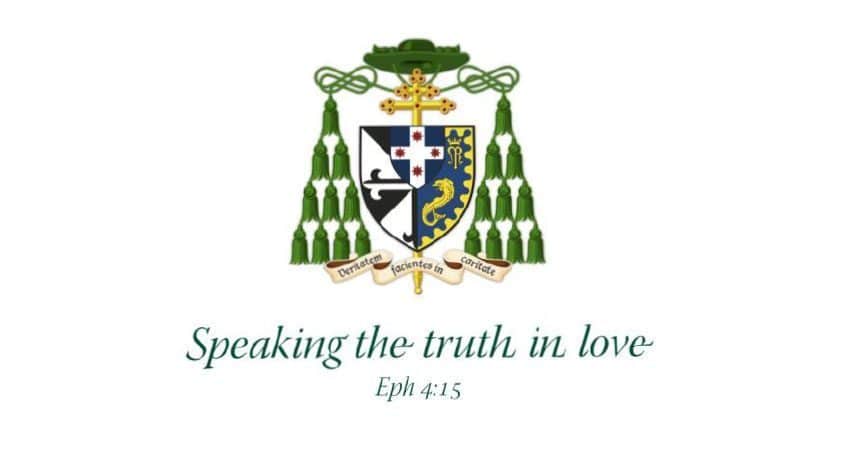HOMILY FOR THE PONTIFICAL MASS OF CHRISTIAN BURIAL FOR REV. JOHN NEILL O.P., O.A.M.

St. Benedict’s Church, Broadway
Dominicans can be very black and white: St Dominic’s mother dreamed of him before his birth as a black-and-white dog carrying a torch to light up the world;[i] their habit, given by Our Lady, is also black and white;[ii] and so is their coat of arms.[iii] Why those colours? Let me suggest five reasons…
First, books and writing are black and white, and the Order was founded to study the sacred page and preach the Word, in season and out; the Dominicans were also charged with making their common life a living book in which people might read of Christ. Even if he was no academic, John loved the study of our faith and even more its preaching. His words of faith and compassion touched many and deeply. He contributed whole-heartedly to the lived homily that each Dominican community is supposed to be, at least until 7PM.
Secondly, the first day of creation was black and white, as God introduced light into the abyss of chaos and nothingness. The Dominican Order was founded to preach the goodness of creation against a contrary heresy and John was a natural for this task. A great believer in the Thomist aphorism that ‘grace builds on nature’, John saw goodness in everyone, beauty all around him and graced abounding; he treasured architecture, art and cinema; and he walked this city’s every nook and cranny. In our first reading Isaiah prophesies a time when there will be no more grief but “a banquet of rich food and finest wines” instead (Is 25:6-9; cf. Ps 22(23)). John was impatient for that feast and wanted it not just for himself but for his brethren, staff, students and parishioners. He used to give the leader of this campus none-too-subtle hints that some anniversary of his was coming up and that people would surely want to celebrate it with a Mass and party!
Thirdly, people speak of truth as black and white and veritas is the motto of the Order. When the great John Henry Newman became a Catholic he considered taking the white wool of Dominic himself. Though that was not to be, he did establish a Catholic university in Ireland and did write the definitive text on The Idea of a University (1854). Exactly a century later that call was taken up by the young John Neill. In due course he was to be a school teacher, principal, education commissioner, founding father of two Catholic universities, and university chaplain.
In that last role many remember John fondly ‘loitering with intent’ in the courtyard to chat with or absolve whomever approached him. Or as praying, preaching and consecrating in this church. Like St Dominic, who died eight centuries ago this month, John was never a Professor himself but he enabled many others to be teachers and students. No Australian Dominican has made a greater contribution to education or has a greater claim to wear the black cappa that is the origin of the academic gown.
Fourthly, black and white became the team colours of the Dominicans—friars, sisters and laity. In donning the habit they are grafted onto the family tree of an extraordinary range of saints and immersed in a family tradition of not a few eccentrics. Fr John loved the Order and its practices. He was regular at conventual Mass and offices, community meetings and meals. And his time as the Order’s formator of future priests yielded important fruit: one of his protégés is now parish priest of this parish and another the Provincial.
Fifthly, some read Dominican white as representing the joy and purity to which friars aspire, and black their penance and humility. John was a man of joy whose enthusiasm for Christ, Church, Order, indeed all life was contagious. But there were trials also, which he endured with modesty and tranquillity. He had heart problems and frailty. He had stresses, such as when the Adelaide constabulary took an interest in a fundraiser poker night for Blackfriars school. He knew misunderstanding: when hosting Bob Hawke at the opening of a new school building and boasting about the school’s philosophy programme, he met incredulity from a Prime Minister who thought faith opposed to reason; John gently disabused him of this prejudice! Likewise with those who thought ‘Catholic’ and ‘university’ contradictories: John knew the Church invented the university, founding so many of the great ones and still sponsoring many. More importantly, with John Henry Newman and John Paul the Great, this third John insisted there could be no opposition between fides and ratio, Catholic and university: if one dimension limps, so does the other; but what unites them is the open-minded, humble but confident pursuit of truth.
John had a particular devotion to the image of the Crucified. He kept a crucifix on the pillow of his well-made bed, gazed upon one on the High Altar at St James’ and sent people to pray at the standing cross near our bell tower. But in pride of place in his cell was an image of Christ enthroned upon the cross, now risen and crowned, His mission accomplished, His victory won, as we heard in our Gospel (Lk 23:44-24:6) and as was John’s certain hope for us.
So Fr John was indeed a man of black-and-white, in the senses of being one who studied, preached and lived the sacred page; one who appreciated and helped others appreciate the beauty and goodness of God’s creation and man’s; one who pursued the truth and enabled many others to do so through education; one who found his identity within a long and meaningful tradition; and one who demonstrated joy and purity, penance and humility.
Dominicans like John are black and white sort of guys—and that scares some people. To the historically minded, it might suggest the Order was infected with the very dualism it was founded to oppose. To more modern eyes, black-and-white can seem too primitive, binary, even fanatic. Black and white thinkers are said not to appreciate the shades of grey, let alone the other colours. Not so John. He knew enough physics to insist that white contains all the colours and nuances, and black allows the contrast that brings them to the fore. Like Caravaggio he was a master of chiaroscuro, of light and shade, in words if not paint.
I knew John as a merciful religious superior, as a wise predecessor as Student Master, and my beloved brother in St Dominic and father in Christ. Following St Thomas Aquinas the Second Vatican Council taught that religious life should be a school of perfection in charity, where in Paul’s words today the inner self is renewed day by day (1Cor 4:14-5:1). To be honest, it doesn’t always work: but in John’s case it did!
John had been readying himself for death for decades. There were many scares, and all his innards were by-passed and then the by-passes by-passed. As a result he had many retirement parties, but he’d be back at work the next day! Such was his devotion to the staff and students, to the truth they pursued and the God who is the ultimate answer to their quest. After so many practice runs he was ready for rebirth into eternal life, presenting to the Father 89 years of Christian discipleship, 66 of consecrated life and 61 of priesthood. Vale dear father and brother!
INTRODUCTION TO THE PONTIFICAL MASS OF CHRISTIAN BURIAL FOR REV. JOHN NEILL O.P., O.A.M.
St. Benedict’s Church, Broadway
Welcome to St Benedict’s Church, Broadway in Sydney, for the Pontifical Mass of Christian Burial for Rev. Fr John Neill OP, a Friar of the Order of Preachers and priest of Jesus Christ. Recently the Dominicans celebrated the octocentenary of the death of their founder; eight hundred years and a few days later, they gather once more to commend one of their number to God and the communion of saints. Recently the Church in Australia celebrated the bicentenary of Catholic education and I know the education world joins the brethren in their commendation.
Born in Sydney in 1932, Fr John joined the Order of Preachers in 1955, was ordained priest in 1960, and served thereafter in various offices and ministries, including as Prior, Master of Students, Provincial Councillor and Parish Priest of this parish (2005-9). But it was his extraordinary contribution to Catholic education that stands out. John taught (from 1963) at Blackfriars Priory School in Adelaide and then led the school (from 1972) for a whopping 17 years. He served as chair of the South Australian Commission for Catholic Schools, on the Standing Committee of the Headmasters Conference and on the National Catholic Education Commission. He was Director of the University of Notre Dame Planning Office (1988) in preparation for its opening (1989), and thereafter a Trustee and Governor of the University (1996-2009). He was also a foundation member of the Company of the Australian Catholic University (1990-2005) and of its Senate (1992-98). A man of faith, modesty and real kindness, he was especially loved by staff, students and parishioners.
In recognition of his extraordinary contributions Fr John was honoured by the Australian College of Education (Fellow 1986), the University of Notre Dame Australia (Hon. LL.D. 2006 and the film The Quiet Man 2019), the Pope (Croce pro ecclesia et pontifice 2012) and the Commonwealth of Australia (OAM 2014).
Our particular condolences go to John’s sister Carole, and her two sons, Gary and David, and to the family of his deceased sister Janet, including her widower Brian and daughter Claire. Carole will offer some words of Remembrance after Communion. I also recognise Sr Margaret Kealy RSJ (John’s cousin) and Mr Richard Aldridge (his dear friend). I welcome all John’s relatives, friends and admirers joining us by live-streaming.
Concelebrating with me today are Father Laurie Foote OP (Prior of St James’ Priory Forest Lodge) and other members of Fr John’s community. From Fr John’s education family I recognise Professor Christine Bennett, Deputy Vice Chancellor of the University of Notre Dame Australia, representing the Chancellor and Vice-Chancellor; and Professor Zlatko Skrbis, the Vice Chancellor of the Australian Catholic University. I acknowledge the Dominican friars, sisters and laity from around Australia, and the leaders, staff and students of Blackfriars Priory School and the two universities, who are joining us through live-streaming.
Our Gospel this morning narrates the central claim of our faith: that Christ died to save us and rose in the flesh as a promise of eternal life (Lk 23:44-24:6). We now commend our dear brother John to the Lord he served so well, that perpetual light may shine upon him.
[i] https://en.wikipedia.org/wiki/Saint_Dominic#:~:text=Dominic%20was%20born%20in%20Caleruega,Duero%20in%20Old%20Castile%2C%20Spain.&text= The%20story%20is%20told%20that,set%20the%20earth%20on%20fire
[ii] https://www.godzdogz.op.org/godzdogz/quodlibet-31-faqs-about-the-dominican-habit
[iii] Charles Daley, ‘The coat of arms of the Order of Preachers,’ Dominicana 13(4), 271-79; 14(1) 33-42; 14(2) 120-130 https://www.dominicanajournal.org/wp-content/files/old-journal-archive/vol13/no4/dominicanav13n4coatarmstheorderpreachers.pdf; https://www.dominicanajournal.org/wp-content/files/ old-journal-archive/vol14/no1/dominicanav14n1coatarmstheorderpreachers.pdf; https://www.dominicanajournal.org/wp-content/files/old-journal-archive/vol14/no2/ dominicanav14n2coatarmstheorderpreachers.pdf; ‘Dominican Order,’ Wiki-Heraldry https://www.heraldry-wiki.com/heraldrywiki/wiki/Dominican_Order.

